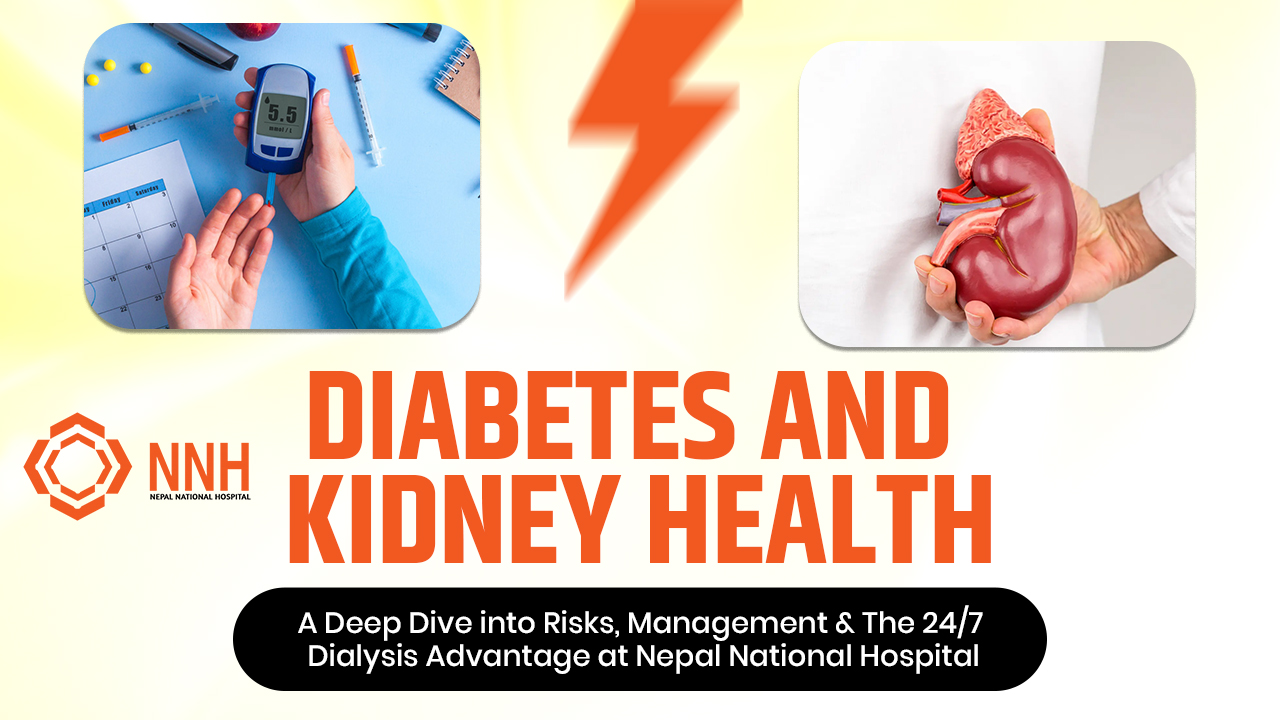Introduction
Diabetes mellitus has emerged as one of the most significant non-communicable diseases in Nepal, affecting millions and imposing a heavy burden on individuals, families and the health system. It is not only the elevation of blood sugar that demands attention, but also the long term complications among the most serious of which is kidney disease (diabetic nephropathy) leading to dialysis dependence. With its 24/7 dialysis service, Nepal National Hospital offers a vital lifeline for patients whose kidneys have been compromised by diabetes. This article explores the scope of diabetes in Nepal, why the kidneys are at risk, how dialysis fits into care pathways, and what patients and health-providers should know.

Diabetes in Nepal: The Scope of the Problem
Recent data indicate that the prevalence of diabetes among adults aged 20-79 in Nepal is around 7.7% in 2024. A systematic review found that in the period 2015-2020 the prevalence of type 2 diabetes mellitus (T2DM) in Nepal was approximately 11.24% (CI 7.89-15.77). The meta-analysis estimated T2DM at 10%, prediabetes at 19.4% and impaired glucose tolerance at 11% across multiple studies. The rise in diabetes is driven by changing lifestyles (urbanization, sedentary behaviour, processed foods), rising obesity and other risk factors.
The high prevalence of diabetes presents a critical challenge: many patients live for years with undetected or poorly managed disease and are vulnerable to complications such as cardiovascular disease, neuropathy, retinopathy and kidney damage.
Why the Kidneys Are Vulnerable in Diabetes
Pathophysiology
High blood glucose over time causes damage to small blood vessels (microvasculature), including those in the kidneys (glomeruli). The filtering units become scarred, reducing ability to excrete wastes and regulate fluids. Hypertension often co-exists, adding further damage. Persistent high intra glomerular pressure and metabolic stress lead to progressive kidney injury.
Clinical Spectrum: From microalbuminuria to full renal failure
The earliest sign of kidney damage in diabetic patients is often an increase in urinary albumin (microalbuminuria). As damage progresses, glomerular filtration rate (GFR) declines, waste products build up, fluid regulation becomes impaired and, eventually, end-stage kidney disease (ESKD) can develop. In ESKD, dialysis (or transplantation) becomes necessary.
Data from Nepal on Kidney Disease
Studies show that diabetes is a leading cause of chronic kidney disease (CKD) and end-stage renal disease (ESRD) in Nepal. A hospital-based study reported that in patients with T2DM, prevalence of CKD was as high as 86.6% in one setting. Nationally, CKD prevalence in Nepal is estimated at 6.0% (95% CI 5.5-6.6) and diabetes was an independent risk factor (AOR ~ 3.2) for CKD. In 2019, approximately 1,895,080 prevalent cases of CKD were counted in Nepal, with age-standardised prevalence rising from 5,979 per 100,000 in 1990 to 7,634 per 100,000 in 2019. A key finding from “Global Dialysis Perspective: Nepal” noted that diabetes mellitus is becoming the leading cause of ESKD in Nepal.
These data underscore that diabetes not only has wide prevalence, but also directly drives serious kidney complications necessitating high-level services such as dialysis.
The Role of Dialysis in Diabetes-related Kidney Failure
When dialysis becomes necessary
In patients whose kidneys can no longer maintain necessary filtration and fluid/electrolyte balance, dialysis acts as an artificial means of removing wastes and excess fluid. For diabetic patients whose kidney function has declined significantly, timely initiation of dialysis can prolong life and maintain quality of life.
24/7 Dialysis Service at Nepal National Hospital
With diabetes driving increased renal demand, having access to round-the-clock dialysis is a major advantage. Nepal National Hospital’s 24/7 dialysis unit ensures that scheduling delays, emergencies (such as acute fluid overload or hyper-kalemia) and after-hours access are minimized. This continuity of care is especially critical for diabetic patients who may experience rapid changes in fluid status, infection risk, or cardiovascular complications.
Integration of multidisciplinary care
Optimal outcomes demand more than dialysis. For patients with diabetes and kidney failure, an integrated care model is essential: tight glycaemic control, blood pressure management, lipid control, diet/nutrition counselling, glaucoma and cardiovascular screening, infection management, foot care. Nepal National Hospital’s multi-specialty platform enables coordination among endocrinology, nephrology, cardiology and nutrition teams.
Prevention & Early Detection of Kidney Complications in Diabetes
Glycaemic control and blood pressure
Keeping HbA1c within target (<7% or individualized) slows progression of nephropathy. Concurrently, achieving BP targets (<130/80 mmHg or as appropriate) reduces glomerular damage. Usage of renin-angiotensin system blockers (ACE inhibitors, ARBs) has a protective effect on kidneys.
Screening and monitoring
Recommendations for diabetic kidney health include:
- Annual urine albumin-to-creatinine ratio (UACR) for diabetic patients.
- Regular estimation of eGFR.
- Monitoring of blood pressure, lipid profile, weight and cardiovascular status.
- Adequate education about symptoms of advanced kidney disease: edema, fatigue, reduced urine output, itchiness.
Lifestyle and risk-factor management
Obesity, smoking, high salt and high protein diet, lack of physical activity all accelerate kidney decline. In Nepal’s context, a meta-analysis found that BMI ≥ 24.9 kg/m² doubled the risk of T2DM. Addressing these upstream factors delays onset of renal complications.
Referral and timely intervention
For patients with rising albuminuria, declining GFR, or new hypertension, referral to nephrology is vital. Early collaboration may slow progression to dialysis.
Patient Journey: From Diabetes to Dialysis; What to Expect
Stages of decline
- Early diabetic kidney change: Slight albuminuria, GFR still normal.
- Moderate nephropathy: GFR dropping, albuminuria increasing, BP rising.
- Advanced CKD (Stages 4-5): GFR very low (<30 mL/min), symptoms present, preparation for renal replacement therapy begins.
End-Stage Kidney Disease (ESKD): Dialysis or transplantation required.
Dialysis initiation
At this stage, discussions include choice between hemodialysis, peritoneal dialysis, or transplantation (when available). Hemodialysis typically 3 sessions/per week in an outpatient setting, but diabetic patients may need more frequent or longer sessions. With 24/7 availability, emergencies can also be managed more effectively.
Care coordination
Diabetic patients on dialysis require careful blood sugar management (dialysis alters glucose handling), close cardiovascular monitoring (highest risk of heart disease), dietary modification (protein, potassium, fluid restrictions) and infection surveillance.
Quality-of-life considerations
Studies in Nepal found that quality-of-life among CKD patients is significantly influenced by comorbid conditions, age, psychological stress and service access. The availability of continuous dialysis service and supportive multi-specialty care help mitigate some of these burdens.
Role of Nepal National Hospital in Diabetes-Kidney Care
Comprehensive screening and diagnostics
Through endocrinology and nephrology units, patients with diabetes receive regular kidney health screening (UACR, eGFR, imaging) and risk-assessment.
Early intervention protocols
When signs of nephropathy emerge, the hospital’s nephrology team initiates renal-protective therapies, lifestyle counselling and referral pathways.
24/7 Dialysis service
Uniquely positioned, the hospital offers round-the-clock dialysis, enabling timely initiation, emergency access, flexible scheduling and better patient outcomes.
Multi-disciplinary collaboration
Endocrinologists, nephrologists, cardiologists, dietitians, infection specialists and nursing staff collaborate under one roof. For diabetic patients with renal involvement, this integrated model ensures comprehensive care.
Patient education and lifestyle support
Recognizing that diabetes and kidney disease demand long-term engagement, the hospital provides patient education programs: diet, exercise, dialysis prep, foot care, fluid management, infection prevention.
Follow-up and long-term management
Beyond dialysis initiation, patients receive regular follow-up for complications, transplantation evaluation (where applicable) and psychosocial support.
Challenges & Considerations Specific to Nepal
Resource constraints and accessibility
While the hospital provides 24/7 dialysis, many individuals in remote areas may lack early screening access, leading to late presentation. The absence of a national renal registry in Nepal leads to under-reporting of incidence.
Lifestyle transition
Rapid urbanisation, sedentary lifestyles, unhealthy diets and rising obesity disproportionately affect younger and urban Nepali adults, increasing risk of diabetes and downstream kidney disease.
Cost and compliance
Dialysis is expensive and burdensome. For diabetic patients, adherence to medications (glycaemic, BP, lipid), lifestyle modifications and screening remains a major challenge in a low-resource setting.
Comorbidity burden
Diabetes rarely stands alone; it often co-exists with hypertension, cardiovascular disease, obesity and lipid disorders. These increase risks for kidney disease progression. Indeed, hypertension was found to have AOR 2.4 for CKD in Nepal.
Frequently Asked Questions (FAQs)
Q1. At what stage of diabetes does kidney damage usually start?
Kidney damage may begin with microalbuminuria as early as 5-10 years after onset of diabetes (or even earlier in uncontrolled cases). However, significant decline in GFR often occurs after several years of persistent hyperglycaemia and hypertension.
Q2. Can dialysis prevent further damage to other organs in diabetic kidney disease?
Dialysis does not reverse damage, but by removing waste and regulating fluid and electrolyte balance, it reduces strain on the body (heart, vessels) and stabilises the internal environment. Early initiation and integrated care help minimise further organ damage.
Q3. Is kidney transplantation an option for diabetic patients in Nepal?
Transplantation is a potential option for eligible patients, but requires careful selection, management of diabetes and cardiovascular risk, and lifelong immunosuppression. Given current infrastructure and cost constraints, dialysis remains the most widely accessible renal replacement therapy in Nepal.
Q4. How often should diabetic patients have kidney screening?
For most, annual urine albumin-to-creatinine ratio (UACR) and eGFR measurement suffice, with more frequent monitoring if microalbuminuria is present or if GFR begins to decline. Blood pressure, lipids and HbA1c should be monitored at least every 6-12 months, or more often if unstable.
Q5. Does controlling blood sugar guarantee prevention of kidney disease?
No guarantee, but tight glycaemic control significantly reduces risk and slows progression. Early detection of microalbuminuria and intervention with BP control and reno-protective medications further reduce risk. Lifestyle factors and co-morbidities must also be managed.
Q6. Why is having 24/7 dialysis service important for diabetic kidney disease?
Diabetic patients often develop complications like fluid overload, electrolyte imbalance, heart failure or infections. Having access to dialysis at any time ensures timely management of emergencies, reduces delay in care and improves outcomes.
Conclusion
Diabetes in Nepal is rising rapidly, and its impact extends far beyond elevated blood sugar. One of the gravest complications is kidney disease, culminating in dialysis dependence or transplantation. Access to advanced services such as 24/7 dialysis is therefore critical. Nepal National Hospital, with its comprehensive approach spanning screening, multi-specialty coordination and uninterrupted dialysis service, stands at the forefront of managing the diabetes-kidney interface.
For individuals living with diabetes, early screening, tighter control of glycaemia, blood pressure and lifestyle factors form the bedrock of prevention. For those whose kidneys are failing, the hospital’s resources and expertise provide a pathway for sustained care. Recognising the inter-link between diabetes and kidney disease sets the stage for proactive management and better quality of life.
